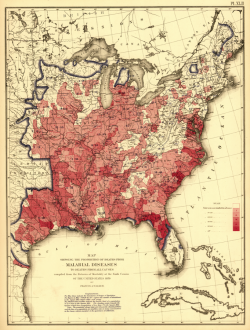Malaria has a long history in the US. Until 1880 it was thought that malaria was caused by bad air ("malaria" comes from the Medieval Italian for "bad air") and it wasn't until 1898 that Sir Ronald Ross of Britain proved that malaria is transmitted by mosquitos. Our capital was built on a swamp (truly a wonder of modern urban planning) and in the summer was notorious for diseases including malaria and yellow fever.
It's easy to forget that until as recently as a century ago, much of the US was still a developing country - industrial manufacturing was low and most people lived in small towns and worked on family farms. The population density was low in many regions and low-lying fields were good farmland and ideal breeding grounds for the mosquitoes that carried malaria when they flooded. Malaria was such a problem in the US that the US Census of 1870 released a map showing areas in the US where malaria prevalence was high (see below).
Michigan's reputation as a hotbed of malaria was well known, as the following quote from the Bulletin of the Medical and Surgical Sanitorium (Battle Creek, Michigan, 1892) shows:
"But what about Michigan malaria? Unfortunately for the reputation of Michigan as a healthful State, the idea got abroad many years ago that the principal feature of its climate was malaria. Going to Michigan was considered almost synonymous with going to have a fit of the ague. It was not supposed to be possible for a person to visit Michigan or even to pass through the State without having the chills."
Apart from being a mere historical curiosity, the high prevalence of malaria in Michigan served as a barrier to development - the rural regions of Central Michigan stand in sharp contrast to the well-developed Southeast and are a legacy of peoples' hesitancy to venture further inland.
So how did we eradicate malaria in the United States? Public health. Even before it was known that malaria was transmitted by mosquitoes, people would clear swamps to reduce the incidence - a classic example of how you can solve a health problem without knowing the exact cause of disease if you understand the risk factors. Once we figured out that mosquitoes were the culprit, much of the eradication effort focused on their elimination. Common practices included land improvement, removal of mosquito breeding sites, and heavy insecticide use. DDT was the most commonly used insecticide, and its use in the 1940's to eliminate malaria lead to severe environmental consequences (for more, see Silent Spring). A very nice (and brief) history can be found here.

 RSS Feed
RSS Feed